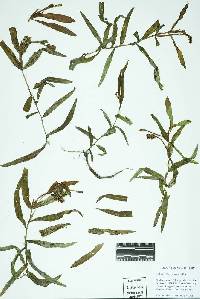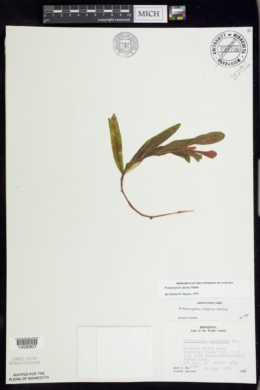Potamogeton alpinus
|
|
|
|
Family: Potamogetonaceae
Reddish Pondweed
[Potamogeton alpinus subsp. tenuifolius (Raf.) Hultén, morePotamogeton alpinus var. subellipticus (Fernald) Ogden, Potamogeton alpinus var. tenuifolius (Raf.) Ogden, Potamogeton microstachys var. subellipticus , Potamogeton montanensis , Potamogeton rufescens , Potamogeton tenuifolius var. subellipticus (Fernald) Fernald] |
Rhizome present. Cauline stems terete, without spots, to 200 cm; nodal glands absent. . Turions absent. Leaves submersed and floating or floating absent, ± spirally arranged. Submersed leaves sessile, lax; stipules persistent, inconspicuous, convolute, free from blade, light brown to reddish, not ligulate, (1.2--)1.5--2.5(--4) cm, not fibrous, not shredding at tip, apex blunt; blade reddish green, oblong-linear to linear-lanceolate, not arcuate, 4.5--18(--25) cm ´ 5--20 mm, base rounded, without basal lobes, slightly clasping, margins entire, not crispate, apex not hoodlike, obtuse or acute, lacunae in 0--6 rows each side of midvein; veins 7--9. Floating leaves: petioles continuous in color to apex, 0.1--1.2 cm; blade reddish green, elliptic or oblanceolate to obovate or oblong-linear, 4--7(--10) cm ´ 10--25(--40) mm, base gradually tapering into petiole, apex obtuse or acute; veins (7--)9--13(--15). Inflorescences unbranched, emersed; peduncles not dimorphic, terminal or axillary, erect, cylindric, 3--10(--16) cm; spikes not dimorphic, cylindric, 10--35 mm. Fruits pedicellate, tawny olive-green, obovoid, plump, turgid, abaxially keeled, laterally keeled or not, (2.5--)3--3.5 ´ (1.7--)2--2.4 mm, lateral keels when present without points; beak abaxially curved, 0.5--0.9 mm; sides without basal tubercles; embryo with 1 full spiral. 2n = 52. Flowering early summer--fall. Ponds, lakes, and slow-moving streams; 400--2500 m; Greenland; Alta., B.C., Man., N.B., Nfld. and Labr., N.W.T., N.S., Nunavut, Ont., P.E.I., Que., Sask., Yukon; Alaska, Calif., Colo., Idaho, Maine, Mass., Mich., Minn., Mont., Nev., N.H., N.J., N.Y., Oreg., Pa., S.Dak., Utah, Vt., Wash., Wis., Wyo.; Europe; Asia Eurasia. Plants of Potamogeton alpinus often are red whenever taken from the water, a feature that makes this species quite distinctive. Two varieties, Potamogeton alpinus var. tenuifolius and var. subellipticus, have been recognized in North America, based mainly on submersed leaf shape. Plants bearing both leaf types have been observed in the same population; hence the varieties are not recognized. Four hybrids, Potamogeton alpinus × P. nodosus (= P. ×subobtusus Hagström), P. alpinus × P. gramineus (= P. xnericius Hagström), P. alpinus × P. praelongus (= P. ×griffithii A. Bennett), and P. alpinus × P. perfoliatus (= P. ×prussicus Hagström), have been described.
Stem slender, somewhat flattened, often branched, to 2 m; rhizomes elongate; lvs sessile, linear, to 2 dm, 2-10 mm wide, 5-13-nerved, the midrib flanked by a pair of
conspicuous bands (each 1-2+ mm wide) of pale green or translucent lacunar cells; stipules 1-3 cm, free; floating lvs usually numerous, linear-elliptic to somewhat spatulate or narrowly obovate, 3-7 cm נ8-20 mm, 11-27-veined, mostly obtuse, narrowed below to a slender petiole about as long as the blade; peduncles about as thick as the stem, 2-5 cm, seldom longer; spikes numerous, cylindric, dense, 1-3 cm; frs obliquely obovoid, 2.5-4 mm, shallowly pitted, the sharp dorsal keel flanked by a pair of lower ones; 2n=26. Ponds and slow streams; Nf. to Que. to s. Alas., s. to Ga., La., and Calif. Gleason, Henry A. & Cronquist, Arthur J. 1991. Manual of vascular plants of northeastern United States and adjacent Canada. lxxv + 910 pp. ©The New York Botanical Garden. All rights reserved. Used by permission. |












































































